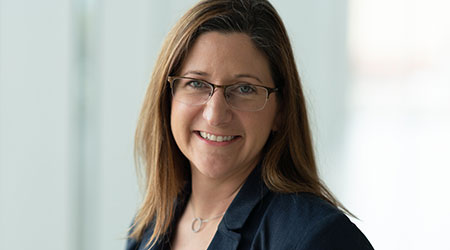 Jennifer DuPlessis Executive Director of Operations Wylie (Texas) Independent School DistrictTexas Association of School Business Officials
Jennifer DuPlessis Executive Director of Operations Wylie (Texas) Independent School DistrictTexas Association of School Business OfficialsChange Agent: Revamping Maintenance for Energy Efficiency, Productivity
Jennifer DuPlessis helps Wylie (Texas) Independent School District recover from a natural disaster while streamlining maintenance and operations.
By Dan Hounsell, Editor-in-Chief
OTHER PARTS OF THIS ARTICLEPt. 1: This Page
There is nothing permanent except change, according to an ancient Greek philosopher. In that case, Jennifer DuPlessis has brought a sense of permanence to her school district. Duplessis is executive director of operations for the Wylie Independent School District in Texas, and since she arrived at the district three years ago, few things within her areas of responsibility have stayed the same. Through a natural disaster recovery, new facilities, major enrollment growth, a presidential visit and an array of upgrades to facilities and department processes, she has enhanced the energy efficiency of her facilities and the productivity of the department.
When and where did your career in facilities management begin?
I started by working in a smaller business unit of a large multinational controls and electrical contractor in January 2001. I was recruited by this company as I neared graduation with a bachelor’s degree in business. I wasn’t really expecting the call from the contractor that was recruiting, but I was really fascinated by the idea of doing facilities work because it was active and there was something going on every day.
I stayed with that contractor for about 10 years. Then I worked for another very large Fortune 500 company for about two years. I enjoyed that, but then I was recruited to work for the Arlington Independent School District, which was developing an energy management program. They didn’t have an energy manager, and they were spending about $15 million a year on utilities. It was really appealing to me to be able to start from the ground up. I had worked with a lot of school systems and universities and even cities and watched their internal struggles trying to get good programs up and running, so it was really appealing to go into a school system and start working through that from the internal side and building a funding program.
What is the role of credentials and certificates in the profession?
I’m not certain that the certifications themselves were stepping stones because when I was coming up through facilities management, certifications were very new. I have a bachelor’s degree in business, and I went on to get an MBA in strategic management. That educational background helped me tremendously in learning how to set up my operation, how to manage budgets, how to plan fiscally — those types of things.
I’m also a Certified Energy Manager through Association of Energy Engineers. I earned that about 10 years ago, which was kind of late in the game because I already had been working in the business for some time. But I felt that having a certification would demonstrate my knowledge, particularly since I’m on the younger side of folks in facilities management and being a female in a male-dominated industry. I felt like having that would demonstrate that I did have the knowledge necessary to do the job.
What advice would you give to someone looking to advance in facilities management?
Your development and what you choose to do in facilities management is really up to you. It’s about how much you desire to learn and how much of yourself you’re willing to invest. How much extra time and energy are you willing to give to step out and take on more, even if it’s not necessarily your job?
Facilities management is unique in that there are so many varied career paths and opportunities. Probably the most important things are to be service oriented, to be a critical-thinking problem solver, to be strategic and to be tireless in seeking to improve your area of responsibility. It’s helpful to reach out to others. I’ve been fortunate to have a couple of people that I worked with over the years who will challenge me.
What are your daily responsibilities related to maintenance and engineering?
I have responsibility over maintenance, custodial, grounds, construction, warehousing, and student nutrition. Frankly, student nutrition was new to me three years ago. But it’s a business, and it’s interesting how similar it is to running a facilities department from the standpoint of getting the right people on board, creating processes and procedures and budgeting.
I probably spend the majority of my time focusing on the long-term direction of our facilities function. Because this is a school district that is growing very quickly, I spend a lot of my time looking at future enrollment increases and deciding what are our opportunities to create facilities. We’re building a lot, so where do we place these facilities, how do we plan them, and how do we structure them?
Secondarily, my focus is on the maintenance side. And with my background with MEP work, which is still my first love. I really enjoy sitting down with the HVAC guys and talking about what PM are we doing and what capital projects do we need to be planning? I’m proud of our group here. We’ve managed to get into the top 10 percent in the country in our response times on work orders.
What kinds of energy-efficiency projects have you undertaken in recent years?
Energy efficiency is something I’ve been doing my entire career, and there are so many opportunities for energy efficiency in everything we do. So we’re looking at everything we do and looking for ways to make it more efficient.
When I came in, it was on the heels of a very large hailstorm that affected the entire geographic area of Wylie, but it didn’t touch the outlying areas. So all 20 campuses required roof replacements. All 20 campuses required rooftop units. It took about seven months to complete everything. We were definitely focused on speed and getting everything up and running.
We did stadium lighting replacements, where we were getting insurance to replace them. So we retrofit those to LEDs, and we had one of the first LED stadiums in our area. We went with higher-efficiency chillers and higher-efficiency DX units that we put on the roof. We did some power factor corrections.
At the time of the hailstorm, we were in the middle of a bond program, so we were building a new elementary school named George W. Bush Elementary School, so, “No pressure, the president’s coming.” But we were able to get that project complete and really look at making sure we were using the most efficient equipment at the time.
We also did some cooling tower optimization, and we implemented a real-time energy dashboard and a green team. When I came to the district, we had little energy-efficiency awareness as far as the staff was concerned. The maintenance department was doing a lot to be efficient with the HVAC operations and things of that nature, but there really was no sustainability or energy-efficiency mindset.
What challenges did you encounter during the projects? How did you address them?
The biggest challenge was getting the hail damage repaired as quickly as possible while school was in session. So we had to take a quick but thorough approach in trying to get ahead of these projects and making sure we weren’t just replacing like for like. That was very challenging to make sure we were replacing everything as quickly as we could while also making sure we were getting any rebates or incentives. We spent every weekend for seven months with helicopters flying in this city removing and replacing rooftop units.
We also were opening a new elementary school that fall, and that was on a very tight timeline because our enrollment was increasing so rapidly. It was definitely a pressure cooker. That elementary school needed to be open and it needed to be perfect because the president was coming.
For my staff, a lot of them had no roof. So they did these things all day, and then they had to go and figure out how to take care of their own families. It was challenging to get people to be continually engaged, but I was impressed with the way people gave their own time and energy when they had such challenging situations at home.
What were the results of the projects in terms of savings? What lessons did you take from the projects?
All of the projects were completed on time and within budget. We also have seen our energy usage continue to lessen about 8 percent from the first to the second year. We’re adding on to our facilities, so we have to look at our energy use intensity as opposed to our total spend and our total usage. But we are seeing that our energy usage has decreased as a result of the decisions that we made during that process.
The power factor corrections are performing great. We’re seeing 95 percent and above. We’re not seeing power factor correction penalties on our bills, so our payback for that is still at the originally estimated four and a half years for the campuses where we did that.
What role does change play in your approach to facilities management?
There were some inefficiencies in the way we were operating before I came on board. When I came in, for example, we had an automated maintenance work order system, yet we were still printing out work orders and sticking them in boxes, which just about made my head explode. The great thing about the situation is that our staff was excited about change — a little frightened on the front end because somebody new was coming and making changes.
We went to mobile work orders. They all have iPhones, and they can all do their work orders on their phones. They liked the fact that they could pick up the phone and call the person who submitted the work order to ask questions and get clarifications and get the job done and move onto the next thing. They saw significant improvements very quickly, which got everybody on board.
People need to own their piece of work, whatever that is. My role was to decentralize our decision-making as much as possible. So when we’re doing $60 million with of hail repairs and improvements and another $50 million in bond improvements and I’ve got eight months to complete it all, I can’t make every decision. It was very important for me to sit down with our crew to talk about our mission and our goals: “Here’s what it is. Now go do it. Tell me the tools you need, and I’m going to give you everything you need to accomplish the goals.”
Related Topics:












